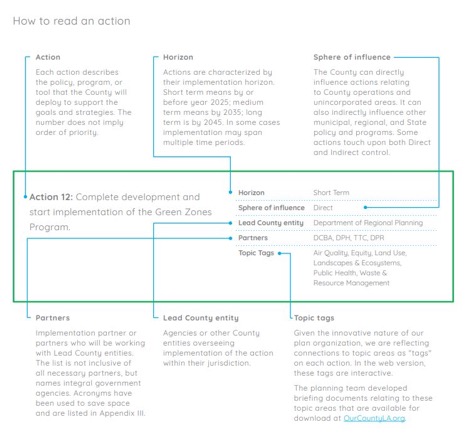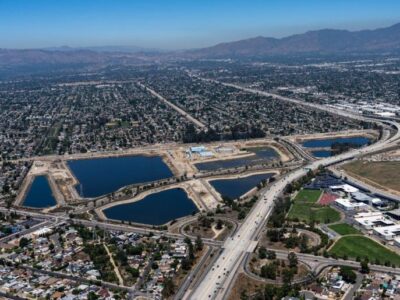The LA County Sustainability Plan
An innovative approach to ambitious goals
Last week, the Los Angeles County Board of Supervisors unanimously approved the LA Countywide Sustainability Plan. Along with my colleagues Sean Hecht and Nat Logar and other faculty across UCLA, I assisted in the drafting process and witnessed the shaping of the Plan from the ground up. The final Plan provides a best practices model for other counties and regional governments to look to for guidance on designing sustainability plans focused on people’s livelihoods, improving equity, and addressing complexities in governance authority.
This Plan is simultaneously ambitious and structurally unique, a necessity given the County’s context. Los Angeles County is the most populous county in the United States, comprising over ten million residents and 88 cities, and represents a range of ethnic groups, incomes, and jobs. Further, the level of county control over sustainability policy differs from that of cities, which hold more direct authority than a county would (except in unincorporated areas, where the County governs the way cities do). Finally, given the wide range of stakeholders needed to achieve the County’s goals, the County Sustainability Office will have to coordinate implementation efforts among the wide range of cities, agencies, and other stakeholders.
This Plan has been widely praised for its ambitions to eliminate fossil fuel use by 2050 while also ensuring economic equity during this energy transition. But for local planning geeks like me, the Plan is novel for its distinct form as well as its function, and it’s important to note how this structure will help with future implementation of the plan.
People-focused sustainability goals
The most innovative feature of the Plan is the way its focus on people’s lives shapes its process and structure. It acknowledges the interconnected environmental needs of its residents by identifying goals that would improve the lives of LA residents, with an emphasis on equity issues. The Plan isn’t organized like many others, which consider environmental factors (water, energy, land use, air, etc.) in silos. Shaping goals in terms of people-focused aspirations is compatible with addressing those factors. But this format recontextualizes the importance of improving them in terms of the benefits to the longevity and prosperity of County residents. And in addition to its general focus on people, the Plan also focuses on issues like biodiversity and open spaces that are frequently overlooked in other sustainability plans.
Readers of the Plan can still view how it addresses each more traditional environmental factor, however, using its online platform. The topic tags listed in each action card allow for those searching for sustainability improvements in specific environmental areas to find them. These topic tags also illustrate the interconnected nature of people-focused sustainability efforts, showing how many stakeholders will need to coordinate to achieve each action, strategy, and goal.
Stakeholder engagement
To reflect the diverse needs of Los Angeles County residents, the drafting process was bottom-up, comprehensive, and transparent. At each stage of drafting, the CSO and team of consultants workshopped the plan with stakeholders in public, private, and non-profit sectors. After each stakeholder workshop, drafters compiled and summarized notes on stakeholder conversations, which are available to the public, and discussed them in detail to incorporate into the plan. While these stakeholder workshop summaries are not technically part of the Plan itself, they help instill confidence from the public that the Plan is constructed with LA residents as its central focus.
Managing expectations
Finally, the Plan explains the County’s authority to achieve ambitious goals systematically within each Plan action, helping to manage the public’s expectations about what’s possible. The Plan is comprised of twelve goals, strategies for achieving those goals, and specific actions that are designed to accomplish those strategies. For each action, the Plan enumerates a time horizon for implementation, a designated lead county entity to take charge of the action, any partner organizations that could help, and where the action falls within the County’s sphere of influence (meaning the amount of control the County government directly has, or doesn’t have, over the action). These “action card categories” (definitions detailed in image below) signal to the public what the County can do, how long an action should take, and which agencies would be responsible. In creating these categories, the CSO is honest about its (sometimes limited) role and ability, while acknowledging what is required to attain its ambitious goals.
Further, the CSO collaborated with County agencies to ensure these categories are accurate. For this reason, agencies and residents alike can have confidence that each agency listed on an action card has verified its ability to accomplish the action, the time required to complete it, and its relative level of influence to complete that action. Not only does this create reliable expectations for the public, but it also illustrates the amount of accountability each agency should have on an action-by-action basis. Residents will be well-informed about what each agency should be accountable for achieving, and other local governments will better understand their roles relative to the County.

Structured for progress
The Plan is notable for its monumental ambition to achieve a fossil-fuel free Los Angeles County, an especially significant goal given that the County houses multiple oil refineries, that freight transportation is a crucial piece of our economy, and that fossil fuel development and deployment have historically been economic drivers in the region. This Plan serves as a reminder that governments are capable of creating plans that simultaneously are ambitious and make themselves accountable for their plans. Indeed, the combination of ambition and accountability is crucial for implementing meaningful change. As the clock ticks closer to irreversible climate catastrophe, and as economic and income inequality continues to rise along the lines of race and gender, all governments must ensure their plans can be implemented in time. The CSO has done so by creating a Plan that is people-focused, locally engaged, and realistic. The LA County Sustainability Plan serves as a model of the capability for ambitious, substantive plans to also be accountable and reliable.
Reader Comments
One Reply to “The LA County Sustainability Plan”
Comments are closed.







LA County deserves credit for its efforts to achieve sustainability, but “goals” is a more accurate description of its report than “plan.”
For example, the report sets a zero-carbon target by 2050, but does not provide specific implementation other than 10 GW of distributed energy sources (“Technologies such as rooftop solar energy systems”) by 2045. That is a good start, but it will supply less than half of the demand. Currently, the City of Los Angeles alone (40% of the County population) consumes approximately 8 GW (primarily produced by natural gas) and its demand, along with the rest of the County, will likely grow in the coming decades. The Los Angeles Department of Water and Power is scheduled to take the Intermountain coal-fired plant in Utah offline in 2025, but it will replace that plant with natural gas.
Again, the County has made a good start. But it needs to do more, including development of municipal and industrial power plants powered by renewable sources, and investment or support for innovative battery and storage technologies, as well as hydrogen, tidal and wave power.